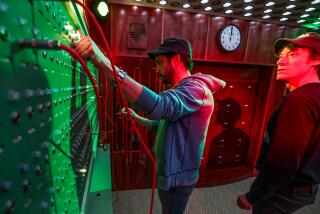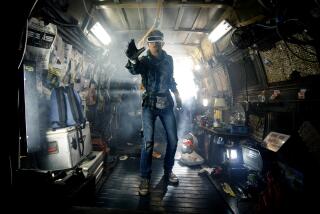Magic Leapâs augmented reality gear meets actual reality, and stumbles
Techâs ânext big thingâ is looking more like a âmaybe in a few more years thing.â
Magic Leap, a Florida start-up, has raised $2.3 billion (yes, billion) from investors on the promise it can mix computer-generated images into regular human sight. Think PokĂŠmon Go built into glasses. Cloaked in secrecy for seven years, it released dazzling demo videos and let a few sample its newfangled View Master under controlled conditions.
Now come the unvarnished reviews. The companyâs first product, the $2,295 Magic Leap One, recently began shipping to developers. The Washington Post bought a pair, and Iâve been using it to test the Magic Leap augmented-reality experience.
Hereâs my real reality experience: Right now, Magic Leap isnât even a very good parlor trick. The product lets you walk around a room, tethered only to a disc-shaped computer worn on your hip, and experience a few 3-D apps that map into the space around you. But it is not dramatically better than competing (and not terribly compelling) AR gear already out there, such as Microsoftâs HoloLens.
Palmer Luckey, the ex-CEO of virtual reality pioneer Oculus and a rival, has been even more pointed. This week, he wrote, âMagic Leap is a tragic heap.â (The company says he misunderstands its tech.)
Why should you care? You probably wonât be buying a Magic Leap anytime soon. But weâre not going to be staring down at phone screens forever, ignoring family members and walking into traffic. Apple and other tech companies are eyeing AR as a phone replacement, too. AR glasses have wider potential than virtual reality gear, which in effect blindfolds you. The Magic Leap goggles, called Lightware, are translucent. When you wear them, it looks like a virtual world is painted on top of the real one â a creature is running around your desk, a web browser window is hanging on your wall.
There is, no doubt, a lot to be worked out for a new kind of computing device. But Iâm surprised Magic Leap isnât further along on the basics â or even just some experiences to make you go âwhoa.â The Magic Leap One canât be dismissed as just a prototype. Not only is it for sale, the company has announced a partnership to, at some point, bring a product to AT&T stores for demonstrations. Magic Leap says this first version is for âcreatorsâ and programmers.
Most curious: The company blamed some of my challenges on an improper fit of its headgear. My fit had been set up by an agent Magic Leap sends to deliver all purchases. I was left wondering how the company will ever sell the product to millions if hardware calibration is that delicate.
So whatâs it like? Here are six things that stand out.
Only a fraction of your view gets augmented, which ruins the magic.
The ultimate test for any augmented-vision tech: Do you feel like youâre in a different world ... or at least on some hallucinogenic substance? You can see some trippy things, but thereâs no way youâll forget whatâs producing them.
Looking through these lenses, itâs like there is a box that fills about half the frame where all the 3-D images appear. If you move slightly, the virtual object youâre looking at gets awkwardly cropped. Magic Leapâs field of view â about 50 degrees â is a bit wider than some rivalsâ. But it still isnât enough to feel like a leap.
A few other factors also ruin the fantasy. Virtual objects that are supposed to be black can appear transparent. And the colors in general are like neon.
It tired my eyes quickly.
After about 20 minutes of wearing the Magic Leap One, my eyes started to feel like Iâd been staring at a laptop screen for six hours. The same happened to a colleague who doesnât normally wear glasses. This doesnât happen to either of us with VR headsets.
Magic Leap says our eyestrain is uncommon. You canât wear glasses inside the device, though Magic Leap says this fall it will begin to sell corrective lenses you can add onto the device.
Thereâs not much to do with it, so far.
Usually when I test a new kind of technology, I demo it to people of different ages and of different levels of technical expertise. (Iâm available for show and tell at dinners and kidsâ parties.) But that was especially hard to do with Magic Leap because it comes with so few apps.
The best experience is an app called Create. It lets you paint in 3-D and create dioramas with pre-made animated creatures.
Others, like an NBA experience, werenât as compelling. A game called âDr. Grordbortâs Invadersâ is advertised on the device though not yet shipping.
My greater worry is that Magic Leap doesnât seem to have figured out how to offer AR experiences that are fundamentally better than what weâve seen before. Magic Leap says its goal with this product is to get it into the hands of creators who will come up with those ideas.
It is comfy on your head â but you canât pass it along.
The Magic Leap One is more comfortable to wear than many other face computers. Thatâs because the company smartly chose to put the heaviest bits, including the processor and roughly three-hour battery, into that circular computer that clips into a pocket or is worn with straps like a purse. The headpiece itself weighs three-quarters of a pound and sits above your ears, higher on the back of your head than you might think.
Unfortunately, the individually calibrated nature of the product makes it hard to just hand your glasses over to a buddy to try.
âSpatial computingâ is cool, but the remote control doesnât make sense.
The best thing about Magic Leap is that it knows where you are in relation to everything else in the room. A bunch of sensors on the headgear map the space around you, so youâre free to just move around the room and interact with virtual things. Canât quite read some text on a virtual sign? Physically move closer to inspect it, just like you would in the real world.
But interacting with the world isnât smooth because of the included remote, which is like a cross between an Apple TV clicker and an X-Box controller. The buttons arenât intuitive in 3-D space, and thereâs not much unity in how you use it in different apps: Is it a trackpad? A magic wand? A lightsaber?
I was confused by the user interface in several apps. For example, in a web browser app, you can leave windows to hang out at different parts of the room. But how do you collect, move and close all the windows you leave littered around the room?
The Magic Leap One can also track your hand movements and the position of your eyes, which could unlock interesting potential. Few apps yet take advantage of it.
Yep, you look like an idiot wearing this.
Google Glass was sunk, in part, by how it made its owners look. The Magic Leap One looks like a prop from âMad Max: Fury Roadâ â very cool if youâre looking for a futuristic costume, but not something youâd wear walking down the street. (Magic Leap doesnât recommend wearing it outdoors, anyway.)
The design also introduces social problems. Though you can see the people around you, they have no idea what youâre looking at â if youâre paying attention, or even if youâre recording them. This information imbalance also contributed to Google Glassâ woes.
More to Read
Inside the business of entertainment
The Wide Shot brings you news, analysis and insights on everything from streaming wars to production â and what it all means for the future.
You may occasionally receive promotional content from the Los Angeles Times.










